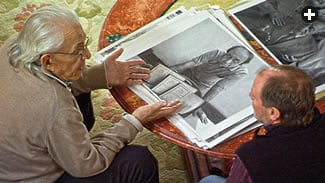 |
| courtesy jwm productions |
| Albanian Muslims helped some 2500 Jews avoid Nazi deportation, and us-based photographer Norman Gershman’s portraits of the Albanians involved, and their descendants, led to The Promise. “This little country, doing what they did, they have something to teach the world,” says Gershman. |
This is unfortunate, because both tell stories that are fascinating, suspenseful and moving, and at the same time, they do public service by documenting virtually unknown histories with unexpected, unforgettable heroes.
Enemy of the Reich: The Noor Inayat Khan Story is a docudrama exploring the life of an Indian-American Muslim woman who became one of Britain’s least likely but most effective spies in Nazi-occupied Paris. Besa: The Promise is a documentary that tells the story of how countless Albanians, adhering to an ancient code of honor that bound them to shelter strangers in need, gave sanctuary to at least 2500 Jews.
While the characters in these films come from very different backgrounds, and the films are told in different styles, together they break new ground by portraying the stories of Muslim heroes during World War ii.
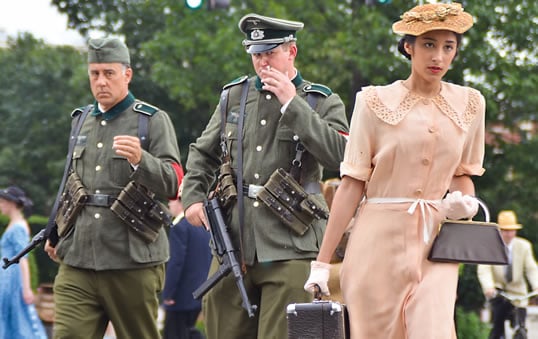 |
| courtesy unity productions foundation |
| In Enemy of the Reich, Grace Srinivasan plays Noor Inayat Khan, who disguised her British radio transmitter with a secretary’s typewriter case as she moved about, sometimes daily, for some four months in Nazi-occupied Paris. |
Because the Holocaust was overwhelmingly carried out in Christian-dominated Europe, it is easy to forget that the Nazis and their allies extended their reach into North Africa and heavily Muslim Balkan regions of Europe, and that the people in those lands, too, were resisters and rescuers.
“At every stage of the Nazi, Vichy, and Fascist persecution of Jews in Arab lands, and in every place that it occurred, Arabs helped Jews,” wrote Robert Satloff, historian and executive director of the Washington Institute on Near East Policy in his 2007 book, Among the Righteous: Lost Stories from the Holocaust’s Long Reach into Arab Lands, one of the few historical examinations of the subject. Satloff found that although Arabs in Nazi-occupied Arab lands collaborated or stood by in roughly the same proportions as Europeans under Nazi occupation, many Arabs and Muslims spoke out against the persecution, and took public stands of unity with Jews, while others withheld the support that would aid the persecution efforts. “Some Arabs shared the fate of Jews and, through that experience, forged a unique bond of comradeship. And there were occasions when certain Arabs chose to do more than just offer moral support to Jews. They bravely saved Jewish lives, at time risking their own in the process.”
The roots of Enemy of the Reich go back to Alex Kronemer and Michael Wolfe, founders and producers at Unity Productions Foundation (upf), who each, in almost the same week in 2010, was approached by different Holocaust survivors from France, each with stories about how they had been aided by Muslims. The stories were revelatory for both producers, neither of whom had ever heard of Muslim heroism during the war.
“Having both these conversations in such a short time, we felt the universe was speaking to us, and we decided to look into this further,” says Kronemer.
Soon, they found more stories. For example, Indian and Algerian Muslim soldiers both also fought in Europe, for the British and French respectively, while doctors at the Franco-Muslim Avicenna Hospital in Bobigny, France, treated American and other Allied soldiers. The French cabaret singer Simon Halali was one of a number of Jews given refuge in Paris’s Grand Mosque, where Muslims provided him with forged documents that changed his first name to Salim and identified him as a Muslim, a story recalled in the 2012 film Les Hommes Libres (The Free Men), which remains available only in French.
While the filmmakers found several stories that could have made for strong documentaries, they pursued the story of Noor Inayat Khan because of her deep spirituality and her position as a woman.
“What made her compelling was that she had this inclusive humanity,” says Kronemer. “The Nazi ideology was opposed to everything she believed in, and she couldn’t sit on the sidelines.”
Filmed mostly in Baltimore and Washington, D.C., using actors from the local stage scene, Enemy of the Reich tells Khan’s story, interspersing segments from scholars and relatives. Academy Award-winning actress Helen Mirren narrates.
“I wanted to portray her because she was such a strong woman who showed such bravery and nerve, but she was also a young woman from unusual circumstances,” says Grace Srinivasan, the actress who played Khan. “She was half Indian and half American, like me, and I don’t often get to read or hear stories about people who look like me. Her story deserved to be told, and I was just excited to be a part of it.”
 |
| courtesy jwm productions |
| Rexhep Hoxha was 17 when his father took in the Aladjem family according to the Albanian besa, or promise, to shelter strangers in distress. In the film, he visits the abandoned synagogue in the Aladjems’ hometown of Vidim, Bulgaria. |
Khan’s father, Hazrat Inayat Khan, was a Sufi Muslim preacher and musician from India who in the years before World War i traveled to America to preach and teach. There, he met Albuquerque-born Ora Baker. They married and moved on to Moscow, where Noor was born in 1914. Shortly afterward, the family moved to London, and then to Paris, where a wealthy patron bought a villa for them on the outskirts of the city, a home that became known as Fazal Manzil, or House of Blessings. Visitors would come to hear her father, and young Noor soaked it all in during what she described as the most idyllic time and place of her life. But it ended tragically when her father unexpectedly died. Noor’s mother became paralyzed with grief, and Noor took over care for her younger siblings.
She went on to study at the Sorbonne, and she became a successful children’s writer, publishing both in children’s magazines and in a collection of short stories. In 1940, ahead of the Nazi invasion of France, Khan and her family fled to England.
There, she joined the Women’s Auxiliary Air Force as a wireless radio operator. After the occupation of France, she was recruited by the Special Operations Executive (soe), a covert unit created by Winston Churchill and tasked to get behind enemy lines to help local Resistance fighters.
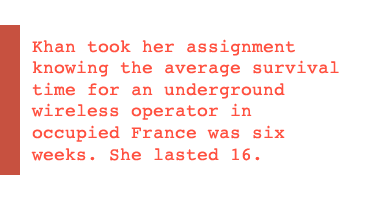 British training records described Khan as idealistic, which her superiors saw as a liability. For example, she told them she refused to lie. The documentary also suggests that the negative reports may have been the result of prejudice against her dark skin and Islamic faith. But her radio skills were excellent, and soe radio operators were desperately needed in France, where Nazi tracking trucks discovered them with ruthless ease. The average survival time on the job was six weeks.
British training records described Khan as idealistic, which her superiors saw as a liability. For example, she told them she refused to lie. The documentary also suggests that the negative reports may have been the result of prejudice against her dark skin and Islamic faith. But her radio skills were excellent, and soe radio operators were desperately needed in France, where Nazi tracking trucks discovered them with ruthless ease. The average survival time on the job was six weeks.
In 1943, Khan was airlifted to a remote rural airstrip and smuggled into Paris carrying a radio in a case that looked much like a secretary’s typewriter. Her assignment was to support an underground Resistance network called Prosper with communications between London and local spies. But Prosper was soon betrayed, and most of its agents were arrested. Khan narrowly eluded capture for about 16 weeks, constantly changing locations, still sending messages to London even as the Gestapo trailed her with radio detectors. She was captured in October 1943, imprisoned and ultimately sent to Dachau concentration camp in Germany, where in September 1944, she was executed.
“I found the challenge to be balancing the light and dark of Noor’s story,” says Srinivasan. “She loved fantasy and make-believe, poetry and art, and almost lived in this imaginary world during her childhood. That side of her is so different from the tough person she must have been to go into France knowing she would probably die there and never giving up despite horrific circumstances. Finding a way to show her layered soul was interesting for me, and the documentary discusses both her fantastic and pragmatic sides.”
Besa—a word that literally translates as “promise” but whose meaning is deeper—began with us photographer Norman Gershman’s desire to document the legacy of Albanians who sheltered Jews during World War ii. In 2002, on his first trip to Albania, which is today roughly 70 percent Muslim and 30 percent Christian, he was astonished at what he found: not just a few people who were exceptions in a sea of bystanders, but rather an entire country that worked to save Jews in accordance with the traditional code of honor known as Besa, which requires that the stranger in distress who seeks shelter must receive it.
When Gershman showed his photos to his friend and film producer Jason Williams, founder of JWM Productions and a specialist in cultural programming, the pair agreed that there was a movie that could be made.
“This film provides the testament of Muslims that the Holocaust happened, and just as significantly, it tells the story of Muslims who took right action in relation to the threat at a time when most Christians didn’t,” says Williams.
“This little country, doing what they did, they have something to teach the world,” says Gershman in the film. Indeed, Albania is the only country that came out of World War ii with more Jews than before the war.
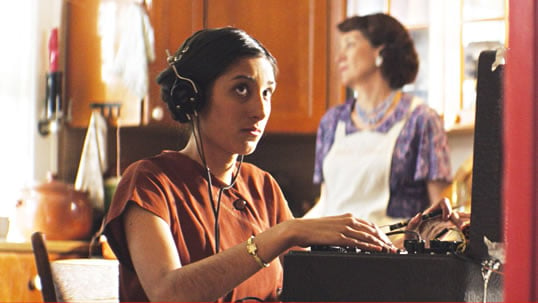 |
| courtesy unity productions foundation |
| Fluent in French and raised as a pacifist in a deeply spiritual Muslim family, Khan learned radio skills after joining the British Women’s Auxiliary Air Force. As an underground wireless operator in occupied Paris, she was often the sole link between Britain and the French Resistance. |
The documentary, however, is more than a look back. It intertwines a suspenseful mystery and quest that unfolds in the present. Rexhep Hoxha was 17 when his father, Rifat, a pastry baker who was “born poor and died poor,” first told him how the Jewish family of Nissim and Sarah Aladjem, with their 12-year-old son Aron, arrived at his store seeking help on one of the ‘ids (holidays) in 1943. The family had fled Axis-allied Bulgaria, which had enacted numerous anti-Jewish laws; Albania at the time was occupied by the Italians who, although allied with Nazi Germany, allowed Jews relative freedom. Rifat immediately closed the store and led the Aladjems to his home, where he gave them a room.
A few months later, the Nazis moved into Albania, and life became perilous for the Aladjems. They fled in 1944, and Nissim entrusted Rifat, by then a close friend, with three heirloom prayer books, which he intended to return for when Albania was liberated.
But after the war, Albania fell under the staunchest communist regime in the world, and it became one of the world’s most closed countries. Only after the communists fell in 1990 did Rexhep see an opportunity to fulfill his father’s wish that the books be returned at last to their rightful owners, which brought the two families together again after more than 70 years.
The Albanians providing refuge to Jews extended from the poorest peasants to the country’s king, Zog i, Europe’s only Muslim monarch, who in 1939 opened Albania’s borders to any Jews who wanted to come in and granted at least 400 passports and countless visas. Among those who came was the family of Johanna Neumann, from Hamburg.
They first stayed with a peasant family outside the Adriatic coastal town of Durres, but after the Nazis arrived, they moved in with the family of Njazi Pilku, an Albanian engineer who had studied in Germany, spoke German and had a German wife, Liza. Whenever the Nazis came to the door to inquire about who the Neumanns were, the Pilkus passed them off as cousins from Germany.
“The hospitality, the warmth, it was a wonderful thing,” says Neumann, who now works as an endowment associate at the United States Holocaust Memorial Museum in Washington, D.C. “That family put themselves at great risk. If the Nazis had found out that they were hiding us, we’d all have been killed on the spot.”
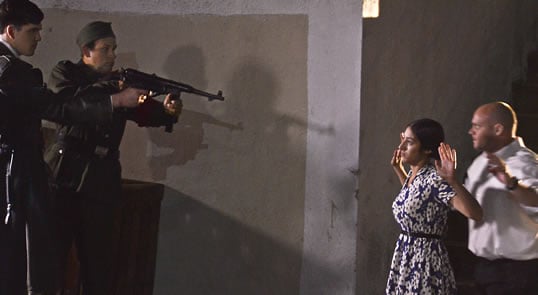 |
| courtesy unity productions foundation |
| Betrayed by a double agent, she was kept prisoner for almost a year until she was executed at Dachau concentration camp. |
To honor their courage further, Neumann in 1992 nominated Njazi Pilku for inclusion at the Yad Vashem Holocaust museum in Jerusalem, where a dedicated hall honors “The Righteous Among the Nations,” non-Jews who rescued Jews during the Holocaust: Pilku is one of 69 Albanians commemorated there.
The Albanians also protected Italians who had been their occupiers yet who themselves became Nazi targets after Italy surrendered to the Allies. Neumann says that Roma (gypsies) also lived in Albania, and that they, too, were protected. “To the best of my knowledge, they weren’t deported,” she says.
“Our timing was fortuitous,” Williams says, noting that at least 18 of the 24 rescuers and rescued interviewed in the documentary have since died. “That’s why this work is so important. If we had not made this film, this record would not exist. There would be no history. This truth will have never been known,” he adds.
Hoxha, too, worries about the many stories that will be and already have been lost.
“Many of the rescuers are not alive today. Certainly many stories will forever remain unlit,” he wrote in an email. “I myself learned much more from the filmmakers, rather than my own father. Also because of the modesty that characterized that generation.”
Released in 2012, Besa continues to be popular at film festivals, winning the Grand Jury Award at the 2014 Nashville Film Festival and best documentary at four film festivals in 2013. Commercial success, however, continues to elude it, and the filmmakers, and some of those who appear in it, worry that the film’s message is not getting out to enough people.
“This is my goal in life, to show the world that these people did this, and to show that the phobia that exists against Muslims is the result of people not knowing and not thinking,” Neumann says.
Enemy of the Reich has screened in about 25 cities to date, mainly at art house theaters, universities, music halls and museums, but it will premiere on pbs Tuesday, September 9.
The filmmakers behind both documentaries also want to see their work distributed to schools for use as educational materials.
“We believe in dialogue and in using film to bring people together,” says Enemy of the Reich co-producer Kronemer. “And we believe this film can really make a contribution to the education of future generations of students, as well as a contribution to improving Muslim-Jewish relations.”
www.enemyofthereich.com
www.besathepromise.com
 |
Omar Sacirbey (osacirbey@hotmail.com) is a correspondent for the Religion News Service and has also written about culture, business and politics for The Boston Globe, The New York Times, Newsweek International and other periodicals. |





